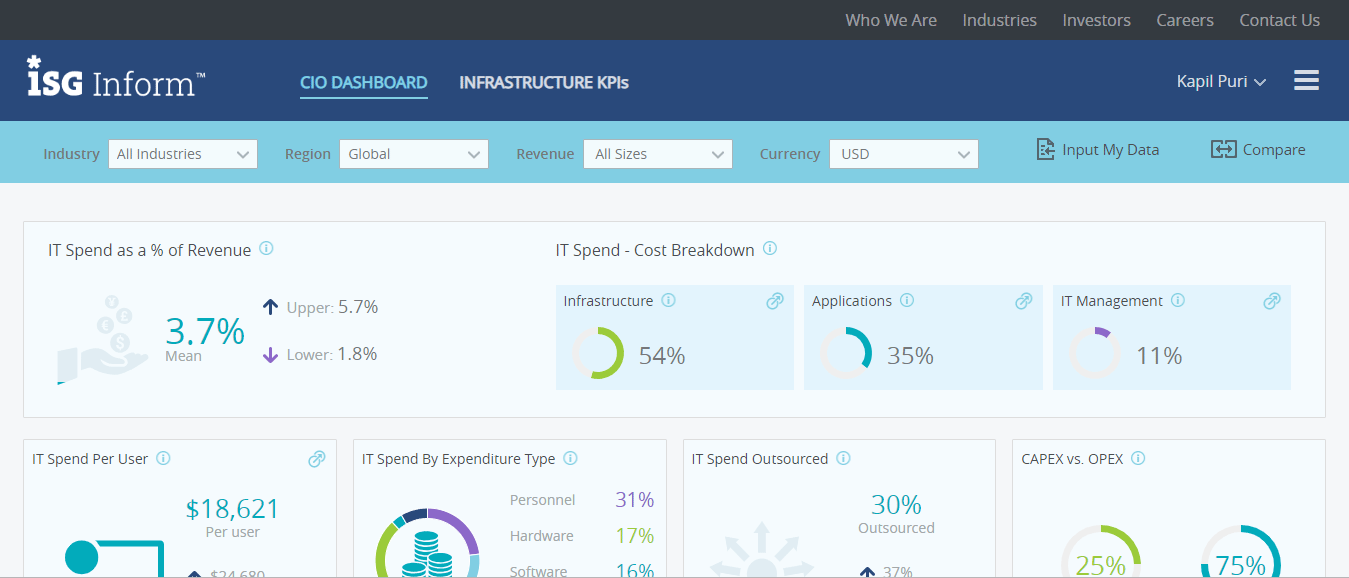Enterprises today allocate significant IT budgets to build applications, enhance existing application code and maintain or support them over their lifetimes. As a part of this effort, enterprises outsource a large volume of ADM work to IT providers as a way to save money. Cost savings can come through a provider’s optimal delivery model by taking advantage of specialized capabilities or by securing provider skills to support an application portfolio or address fluctuations in workloads.
Data from ISG Inform™ shows, that on an average, an organization spends approximately 3.7 percent of its revenue on IT, and of this, around 35 percent is spent on applications, including custom builds and enhancements, custom-off-the-shelf (COTS) products and maintenance.

Source: ISG Inform™
While many organizations tightly control the ADM outsourcing process and negotiate with IT providers for favorable rates, the benefit of these negotiations will bear out only if the companies continue to monitor the contracts with the same rigor. This means enterprises must validate the provider effort for each project, ensure resources have been judiciously assigned, and keep track of the provider’s productivity and code quality.
But it can be difficult to monitor provider performance. Many enterprises face the following challenges:
- Lack of detail. ADM contracts often lack adequate detail about the extent of work providers will perform to execute the desired application development, changes, enhancements or bug fixes. Even when enterprise clients provide the requirements for the work, providers often lack the time they need to provide adequate detail and the motivation to elaborate on the requirements. Most often, high-level “rules of thumb” are applied to create estimates and obtain approval to proceed.
- Lack of time. Enterprises may require time to validate and confirm time-and-cost estimates proposed by the provider, but taking this time often is seen as delaying the process. As a result, enterprise clients may grant hasty approval, relying largely on inputs provided only by the vendor.
- Lack of context. Enterprises often lack an estimating framework to compare the vendor’s proposed efforts with the best in industry.
- Lack of data. Enterprises often lack standardized data sets to benchmark provider submissions against the worst and best scenarios among their peers.
- Lack of skills. Providers often lack the skills they need to validate the proposed ADM efforts.
Experience shows that ADM provider cost-and-price estimates may differ from actual results by as much as plus or minus 50 percent. Both overestimating and underestimating ADM efforts can lead to value leakage. Underestimating the effort needed may lead to frequent change requests by the provider, descoping of functions or poor-quality code delivery. Overestimation can indicate provider inefficiencies or higher-profit margins and client value leakage. Clients should set up a robust cost-estimation framework as a way to optimize effort-estimation practices that help their organization prepare for and sign the most advantageous contract.
ISG helps enterprises select and negotiate ADM outsourcing contracts that work for them. ISG Managed Services on the ISG GovernX® platform provides ongoing support for supplier governance. Our experienced advisers help clients govern supplier performance and compliance and commercials of contracts to ensure service delivery and limit value leakage. This includes helping clients set up and support the practice of ADM estimation validation. Contact us to see a demo.
